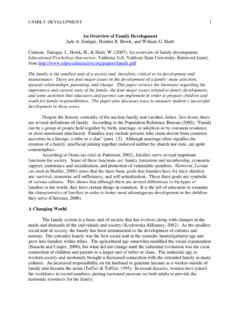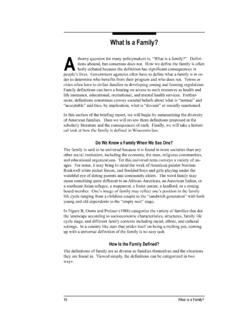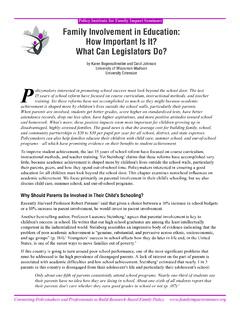Transcription of Fertility of Men and Women Aged Years in the United States ...
1 Number 51 n April 12, 2012 Fertility of Men and Women Aged 15 44 Years in the United States : National Survey of Family Growth, 2006 2010 by Gladys Martinez, ; Kimberly Daniels, ; and Anjani Chandra, , Division of Vital Statistics Abstract Objective This report presents national estimates of the Fertility of men and Women aged 15 44 Years in the United States in 2006 2010 based on the National Survey of Family Growth (NSFG). Data are compared with similar measures for 2002. Methods Descriptive tables of numbers, percentages, and means are presented and discussed. Data were collected through in-person interviews of a nationally representative sample of the household population aged 15 44 Years in the United States between July 2006 and June 2010. The 2006 2010 NSFG sample is comprised of 22,682 respondents including 10,403 men and 12,279 Women . The overall response rate for the 2006 2010 NSFG was 77%, 75% for men and 78% for Women . Results Many of the Fertility measures among men and Women aged 15 44 based on the 2006 2010 NSFG were generally similar to those reported based on the 2002 NSFG.
2 The mean age at first child s birth for Women was 23 and the mean age at first child s birth for men was 25. One-half of first births to Women were in their 20s and two-thirds of first births were fathered by men who were in their 20s. On average, Women aged 15 44 have children as of the time of the interview. By age 40, 85% of Women had had a birth, and 76% of men had fathered a child. In 2006 2010, 22% of first births to Women occurred within cohabiting unions, up from 12% in 2002. These measures differed by Hispanic origin and race and other demographic characteristics. Keywords: parity number of children born age at first birth marital status at birth nonmarital births Introduction This report presents national estimates of different Fertility measures for both men and Women in the United States for the period 2006 2010. Fertility refers to the number of live births that occur to an individual. In 2008, there were million births in the United States (1). The average Fertility of Women in the United States was about seven children at the beginning of the 19th century, it declined slowly and by 1960 it was children per woman (2,3).
3 Fertility in the United States dropped to its lowest point in 1976 at an average of children per woman and has remained relatively stable at around children per woman (1,4 7). While Fertility in the United States has remained stable since the 1970s, there is variation by subgroups including age, race, ethnicity, education, and measures of socioeconomic status . Researchers have often examined the intermediate characteristics that help to explain Fertility such as fecundity (the ability to have children), timing of sexual intercourse, time spent in sexual relationships, and use of contraception (8). Others have looked at timing of Fertility , the composition of those who have children, the number of children born, the union status at childbirth, etc (9 14). The National Survey of Family Growth (NSFG) has collected data on Fertility and the intermediate factors that explain Fertility in the United States since 1973. The Centers for Disease Control and Prevention s National Center for Health Statistics (NCHS) conducts the NSFG.
4 The NSFG is jointly planned and funded by NCHS and several other programs of the Department of Health and Human Services (see Acknowledgments). This report presents selected data on the DEPARTMENT OF HEALTH AND HUMAN SERVICES Centers for Disease Control and Prevention National Center for Health Statistics Page 2 National Health Statistics Reports n Number 51 n April 12, 2012 Fertility experience of 15 44-year-old males and females in the United States using the 2006 2010 NSFG, and also presents trends in these measures since 2002. Background In the last two decades, Fertility research in the United States has focused on timing of childbearing ( , adolescent childbearing), the context of Fertility ( , nonmarital childbearing), and on high Fertility groups. Early childbearing The United States teenage birth rate in 2010 was births per 1,000 females aged 15 19 (5,15). Although this represents a 44% decline from the peak rate in 1991, the United States teenage birth rate continues to be higher than that of other developed countries (16).
5 Within the United States there are large variations in the teenage birth rate by various characteristics including Hispanic origin and race. Having a child at an early age ( , teenagers) is associated with negative social, economic, and health consequences for the young woman and her child (1,17 19). There is debate on how much of the consequences of a teenage birth are the result of the mother s earlier background characteristics rather than the birth itself (20,21). Nonetheless, teenage childbearing in the United States cost taxpayers at least $ billion in 2008 (22). Nonmarital childbearing Over the past several decades, nonmarital childbearing has increased among Women in all ages and Hispanic origin and race subgroups. In 1970, 11% of all live births were to unmarried Women compared with 41% of all live births in 2009 (5). At the same time, there has been an increase in the proportion of Women living in cohabiting unions and a greater proportion of nonmarital births occur to Women living with a partner.
6 One of the concerns with the increase in nonmarital childbearing is that children born outside of a marital union experience more family transitions, less stability, and may have fewer resources (23,24). Another concern with nonmarital childbearing is that a large proportion of births outside of marriage occur to Women who did not intend the conception. Among births between 1999 and 2002, 77% of those to married Women were intended at conception, while only 35% of those to never-married Women were intended at conception (25). Because of this observed relationship, increases in nonmarital childbearing raise public health concerns given the documented adverse effects to babies born to Women who did not intend to become pregnant and for the Women themselves (26 29). Variations by race, ethnicity, and education Fertility levels are also known to vary across population subgroups such as race and ethnicity and educational attainment (5,25,30). Women with lower educational attainment have earlier and higher total Fertility than those with more education (30).
7 A significant proportion of this difference can be explained by higher levels of unintended births among Women with less education (13). In addition, Women with less education are less likely than others to use contraception (31). At least some of the association between early Fertility and educational attainment results from some young Women leaving school early when they become pregnant. Racial and ethnic variation is seen in both the timing of Fertility and total Fertility . On average, the Hispanic and non-Hispanic black populations have earlier and higher Fertility than other racial and ethnic groups (1,30). Considerable research attention has been focused on the high Fertility of immigrant groups; for example, the Fertility of foreign-born Mexican Women is, on average, higher than those who are born (32). Methods Data collection The NSFG was established and first conducted by NCHS in 1973. Since then, the NSFG has been conducted seven times by NCHS in 1973, 1976, 1982, 1988, 1995, 2002, and most recently, in 2006 2010.
8 In 1973 and in 1976, the survey interviewed Women aged 15 44 Years who were currently married or had been married; it was then considered too sensitive to interview never-married Women on Fertility -related topics. In 1982, as the percentage of births to unmarried Women continued to increase, the survey was expanded to include Women aged 15 44 regardless of marital experience. Thus, the sample began to include all females aged 15 44 including never-married teenagers and Women . In 2002, the NSFG began to interview males aged 15 44, allowing analysis of a nationally representative sample of males as well. The 2006 2010 NSFG was based on 22,682 face-to-face interviews 12,279 with Women and 10,403 with men aged 15 44 Years in the household population of the United States . Men and Women living on military bases or in institutions were not included in the survey. The sample did include persons temporarily living away from the household in a college dormitory, sorority, or fraternity (33).
9 The interviews were administered in person by trained female interviewers primarily in the respondents homes. The 2006 2010 sample is a nationally representative multistage area probability sample drawn from 110 areas, or Primary Sampling Units (PSUs) across the country. To protect the respondent s privacy, only one person was interviewed in each selected household. In 2006 2010, persons aged 15 19 and black and Hispanic adults were sampled at higher rates than others. All respondents were given written and oral information about the survey and informed that participation was voluntary. Adult respondents aged 18 44 Years were asked to sign a consent form, but were not required to do so; a very small percentage of adult respondents declined to sign the consent form. For minors aged 15 17 Years , signed consent was required first from a parent or guardian, and then signed assent was National Health Statistics Reports n Number 51 n April 12, 2012 Page 3 required from the minor: If either the parent or the minor declined to give written consent, the minor did not participate in the survey.
10 The response rate for the 2006 2010 NSFG was 77% overall and 75% for men and 78% for Women . The interviews lasted an average of about 80 minutes for females and 60 minutes for males. More detailed information about the methods and procedures of the NSFG and its sample design, weighting, imputation, and variance estimation has been published (33). Demographic variables used in this report The Fertility data presented in this report are shown with respect to several key demographic characteristics including age, marital status , education, parental living arrangements in adolescence, and Hispanic origin and race. Age of respondent, marital status , and educational attainment reflect status at the time of the interview. Educational attainment is shown only for respondents aged 22 44 because large percentages of those aged 15 21 are still attending school. Fertility indicators are also shown for proxy measures of the respondent s socioeconomic status . These include the educational attainment of the respondent s mother and parental living arrangements at age 14.













